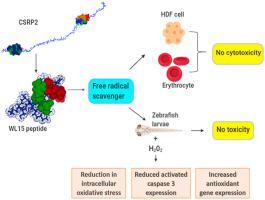Developmental & Comparative Immunology ( IF 2.7 ) Pub Date : 2020-09-10 , DOI: 10.1016/j.dci.2020.103863 Ajay Guru 1 , Christy Lite 2 , Allen J Freddy 2 , Praveen Kumar Issac 1 , Mukesh Pasupuleti 3 , N T Saraswathi 4 , Mariadhas Valan Arasu 5 , Naif Abdullah Al-Dhabi 5 , Aziz Arshad 6 , Jesu Arockiaraj 1

|
Antioxidant peptides are naturally present in food, especially in fishes, and are considered to contain rich source of various bioactive compounds that are structurally heterogeneous. This study aims to identify and characterize the antioxidant property of the WL15 peptide, derived from Cysteine and glycine-rich protein 2 (CSRP2) identified from the transcriptome of a freshwater food fish, Channa striatus. C. striatus is already studied to contain high levels of amino acids and fatty acids, besides traditionally known for its pharmacological benefits in the Southeast Asian region. In our study, in vitro analysis of WL15 peptide exhibited strong free radical scavenging activity in 2,2-diphenyl-1-picrylhydrazyl (DPPH), 2,2′-azino-bis-3-ethylbenzothiazoline-6-sulfonic acid (ABTS), superoxide anion radical and hydrogen peroxide (H2O2) scavenging assay. Further, to evaluate the cytotoxicity and dose-response, the Human dermal fibroblast (HDF) cells were used. Results showed that the treatment of HDF cells with varying concentrations (10, 20, 30, 40 and 50 μM) of WL15 peptide was not cytotoxic. However, the treatment concentrations showed enhanced antioxidant properties by significantly inhibiting the levels of free radicals. For in vivo assessment, we have used zebrafish larvae for evaluating the developmental toxicity and for determining the antioxidant property of the WL15 peptide. Zebrafish embryos were treated with the WL15 peptide from 4 h of post-fertilization (hpf) to 96 hpf covering the embryo-larval developmental period. At the end of the exposure period, the larvae were exposed to H2O2 (1 mM) for inducing generic oxidative stress. The exposure of WL15 peptide during the embryo-larval period showed no developmental toxicity even in higher concentrations of the peptide. Besides, the WL15 peptide considerably decreased the intracellular reactive oxygen species (ROS) levels induced by H2O2 exposure. WL15 peptide also inhibited the H2O2-induced caspase 3-dependent apoptotic response in zebrafish larvae was observed using the whole-mount immunofluorescence staining. Overall results from our study showed that the pre-treatment of WL15 (50 μM) in the H2O2-exposed zebrafish larvae, attenuated the expression of activated caspase 3 expressions, reduced Malondialdehyde (MDA) levels, and enhanced antioxidant enzymes, including superoxide dismutase (SOD) and catalase (CAT). The gene expression of antioxidant enzymes such as glutathione S-transferase (GST), glutathione peroxide (GPx) and γ-glutamyl cysteine synthetase (GCS) was found to be upregulated. In conclusion, it can be conceived that pre-treatment with WL15 could mitigate H2O2-induced oxidative injury by elevating the activity and expression of antioxidant enzymes, thereby decreasing MDA levels and cellular apoptosis by enhancing the antioxidant response, demonstrated by the in vitro and in vivo experiments.
中文翻译:

斑马鱼体内模型证明了半胱氨酸和富含甘氨酸的蛋白 2 对 WL15 的细胞内 ROS 清除和抗氧化调节作用。
抗氧化肽天然存在于食物中,尤其是鱼类中,并且被认为含有丰富的结构异质的各种生物活性化合物。本研究旨在鉴定和表征 WL15 肽的抗氧化特性,该肽源自淡水食用鱼纹鳢转录组中的半胱氨酸和富含甘氨酸的蛋白 2 (CSRP2)。研究表明,纹状线藻含有高含量的氨基酸和脂肪酸,而且在东南亚地区传统上因其药理功效而闻名。在我们的研究中,WL15 肽的体外分析在 2,2-二苯基-1-三硝苯肼 (DPPH)、2,2'-连氮基-双-3-乙基苯并噻唑啉-6-磺酸 (ABTS) 中表现出强大的自由基清除活性、超氧阴离子自由基和过氧化氢(H 2 O 2 )清除测定。此外,为了评估细胞毒性和剂量反应,使用了人真皮成纤维细胞(HDF)。结果显示,不同浓度(10、20、30、40和50μM)的WL15肽处理HDF细胞没有细胞毒性。然而,处理浓度通过显着抑制自由基水平而显示出增强的抗氧化特性。对于体内评估,我们使用斑马鱼幼虫来评估 WL15 肽的发育毒性和抗氧化特性。斑马鱼胚胎从受精后 (hpf) 4 小时到 96 hpf 进行 WL15 肽处理,涵盖胚胎幼虫发育期。在暴露期结束时,将幼虫暴露于 H 2 O 2 (1 mM) 以诱导一般氧化应激。 即使在较高浓度的肽中,在胚胎-幼虫期暴露WL15肽也没有表现出发育毒性。此外,WL15肽显着降低了H 2 O 2暴露引起的细胞内活性氧(ROS)水平。使用整体免疫荧光染色观察到WL15肽还抑制斑马鱼幼虫中H 2 O 2诱导的caspase 3依赖性细胞凋亡反应。我们研究的总体结果表明,对暴露于 H 2 O 2的斑马鱼幼虫进行 WL15 (50 μM) 预处理,可减弱活化的 caspase 3 的表达,降低丙二醛 (MDA) 水平,并增强抗氧化酶,包括超氧化物歧化酶(SOD)和过氧化氢酶(CAT)。发现谷胱甘肽S-转移酶(GST)、谷胱甘肽过氧化物(GPx)和γ-谷氨酰半胱氨酸合成酶(GCS)等抗氧化酶的基因表达上调。总之,可以认为,WL15 预处理可以通过提高抗氧化酶的活性和表达来减轻 H 2 O 2诱导的氧化损伤,从而通过增强抗氧化反应来降低 MDA 水平和细胞凋亡。体外和体内实验。









































 京公网安备 11010802027423号
京公网安备 11010802027423号